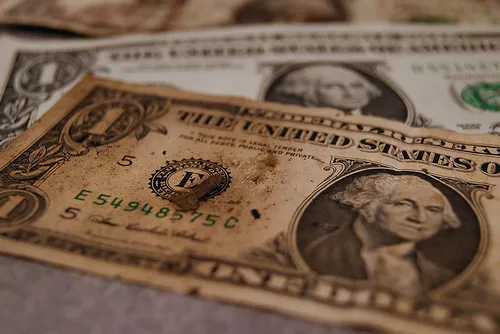Friday, August 19, 2011
News Dirty money
Posted By Rhiannon Fionn on Fri, Aug 19, 2011 at 12:02 PM
It makes sense that money is icky, given the number of hands it passes through, the till drawers it sits in, the cash bags and so on. But, who'd have guessed it's also coated with endocrine disruptors? Scientists, that's who.
The National Resources Defense Council (NRDC) defines endocrine disruptors like this:
An endocrine disruptor is a synthetic chemical that when absorbed into the body either mimics or blocks hormones and disrupts the body's normal functions. This disruption can happen through altering normal hormone levels, halting or stimulating the production of hormones, or changing the way hormones travel through the body, thus affecting the functions that these hormones control. Chemicals that are known human endocrine disruptors include diethylstilbesterol (the drug DES), dioxin, PCBs, DDT, and some other pesticides. Many chemicals, particularly pesticides and plasticizers, are suspected endocrine disruptors based on limited animal studies.
And, here's more on how such things can get cozy with your wallet from the Environmental Health News:
Paper money from countries all around the world carry a chemical hitchhiker — the hormone-active substance known as bisphenol A (BPA). Paper bills are the latest addition to a growing list of items tainted with the ubiquitous chemical that has been linked to adverse reproductive, metabolic and behavioral effects.The study identifies cash as another source of human exposure to BPA, report the researchers who found that BPA can transfer to the bills from thermal cash receipts stored next to them in wallets.
The levels measured in the 50 bills from different governments varied widely — from almost nothing to considerably high amounts. Still, more research is needed to understand human exposures and possible health effects.
...
The researchers did find that the BPA can rub off onto paper money from thermal receipt papers kept in the same wallet. BPA is not chemically bound to the receipts, and in this study it easily migrated to nearby items.
BPA and BPA-containing products may also be used to produce paper money, including ink developers and recycled paper. While these products can contain BPA, it is not know whether paper money is manufactured with them. Its use could explain the contaminant found in paper currencies around the world and account for some of the differences measured in the various currencies.
These results are important because BPA can be absorbed through the skin. Little is known of human exposures through this route, but research suggests up to 27 percent can be transported to the bloodstream within two hours of dermal exposure (Biedermann et al. 2010).
Read more here.
Speaking of...
-

Unlock Your Peak Mental and Physical Well-Being with Telos Wellness
Feb 7, 2025 -

5 Mindset hacks for financial success
Sep 10, 2021 -

A case for gardening
Dec 30, 2020 - More »
Comments
Showing 1-1 of 1











